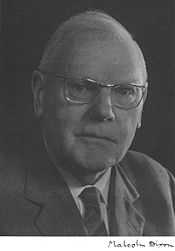Malcolm Dixon
- For the rugby league footballer of the 1960s and '70s for Great Britain, England, Yorkshire, and Featherstone Rovers, see Malcolm "Mal" Dixon
| Malcolm Dixon | |
|---|---|
|
Malcolm Dixon (1899 - 1985) | |
| Born |
18 April 1899 Cambridge, UK |
| Died |
7 December 1985 (aged 86) Cambridge, UK |
| Residence | UK |
| Nationality | British |
| Fields | Biochemistry |
| Institutions | University of Cambridge |
| Alma mater | University of Cambridge |
| Doctoral advisor | Frederick Hopkins |
| Doctoral students |
Brigitte Askonas David E. Green Gregorio Weber |
Malcolm Dixon (18 April 1899 – 7 December 1985) was a British biochemist.
He was born in Cambridge, UK to Allick Page Dixon and Caroline Dewe Dixon (née Mathews).[1]
He received his PhD in 1925, under Frederick Gowland Hopkins at the University of Cambridge.
He studied physical biochemistry, especially the purification of enzymes and the kinetics of enzyme-catalyzed reactions. He studied the oxidation of glutathione and other thiols by molecular oxygen and measured the redox potential of the thiol-disulfide system, also establishing that the oxidation of glutathione was catalyzed by trace metals. He investigated xanthine oxidase, and thereby elucidated many aspects of the chemistry of dehydrogenases. He showed that the hydrogen peroxide formed in the reaction of xanthine oxidase with molecular oxygen inactivated the enzyme and that the inhibition could be relieved by the addition of catalase, thus helping to establish a biochemical role for the latter enzyme. Dixon published a series of papers on D-amino acid oxidase, detailing the kinetics and thermodynamics of association of the coenzyme with the apoprotein, the substrate and inhibitor specificity, and the effect of pH on the kinetic constants.
He was an expert on the theory and use of manometers. In 1931, he collaborated with Keilin and Hill to determine the first absorption spectrum of a cytochrome, cytochrome c. Dixon studied the chemistry of lachrymators and mustard gas and proposed a phosphokinase theory to explain their mode of action.
He was elected a Fellow of the Royal Society in 1942 and Fellow of King's College, Cambridge in 1950. He died in Cambridge in 1985.
References
- Biographical Memoirs of Fellows of the Royal Society, 34, 1988, pp. 98–131.
|
